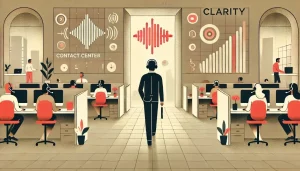In the high-pressure world of contact centers, background noise isn’t just a nuisance—it’s a silent performance killer. Whether it’s a barking dog on a remote agent’s line or overlapping voices in an open office, noise disruption erodes customer experience and agent productivity alike. And in the post-COVID era of hybrid and remote work, the problem has only intensified.
For operations leaders and workforce managers, understanding how noise affects performance metrics like Average Handle Time (AHT), First Call Resolution (FCR), and Customer Satisfaction (CSAT) is the first step toward lasting improvement. The good news? Cutting-edge solutions like AI-based noise cancellation offer scalable relief.
Related: Top 5 Industries That Need Noise Cancellation in 2025

How Noise Disrupts Call Center Operations
The impact of noise goes far beyond momentary distractions. It chips away at the quality, efficiency, and emotional tone of customer interactions:
- Agent Distraction & Miscommunication: Repeating questions, missing key details, and constantly asking customers to speak up disrupts flow and professionalism.
- Customer Frustration: Nothing sours an interaction faster than muffled audio or an agent who seems inattentive—even if the agent is simply struggling to hear through poor audio conditions.
- Morale and Cognitive Fatigue: Agents working in noisy environments report higher stress levels, reduced empathy, and faster burnout. Constantly straining to hear and be heard wears them down over time.
This isn’t just an issue for call centers. A Harvard Business Review article notes that ambient noise in open office environments has been shown to reduce concentration, increase stress, and disrupt collaboration—issues that are magnified in high-stakes, customer-facing roles like contact center work.
Operational Metrics That Suffer from Noise
Even small degrees of background noise can significantly degrade performance across core KPIs:
- Average Handle Time (AHT): Noise leads to more clarifying questions, repeated explanations, and drawn-out conversations—all of which inflate AHT and reduce overall efficiency.
- First Call Resolution (FCR): If a customer’s concern is misheard or misunderstood due to audio issues, the agent may miss important context. This increases the likelihood of repeat calls, callbacks, or escalations, which damages both CX and operational cost-efficiency.
- Customer Satisfaction (CSAT): Poor audio quality undermines customer trust and patience. Frustrated customers are less likely to rate the interaction positively—even when the agent does everything else right. According to the Zendesk 2025 CX Trends Report, 72% of customers say that being able to easily communicate with a support agent is a key factor in a positive service experience—highlighting how critical clarity is to satisfaction and loyalty.
Three predictions, for contact center executives to consider, on how AI will shape the future of contact centersHow AI will Transform Contact Centers in the Next 5 Years
Noise and Agent Productivity
Beyond the metrics, agent well-being is on the line:
- Cognitive Load: Constantly filtering out distractions consumes mental energy that should go toward problem-solving and empathy.
- Reduced Engagement: Agents in noisy or frustrating environments disengage—affecting tone, pacing, and willingness to go the extra mile.
- Burnout Risk: Ongoing audio issues become a chronic stressor, accelerating turnover and eroding team stability. Research published in the Journal of Environmental Psychology found that exposure to acoustic distractions in work environments can reduce cognitive performance by up to 15% and increase reported stress levels. In fact, the CDC’s National Institute for Occupational Safety and Health (NIOSH) highlights workplace noise as a key contributor to occupational stress, with long-term effects on mental fatigue, job satisfaction, and overall health.
Solutions for Noise Disruption
Traditional Options (with Limitations)
- Soundproofing and Booths: Expensive, inflexible, and not applicable for remote staff.
- Noise-Canceling Headsets: Some relief, but they can’t filter what the customer hears or adapt to changing environments.
AI-Powered Noise Cancellation
Modern AI-based tools like Tomato.ai’s noise cancellation technology offer:
- Real-time cancellation of background noise on both sides of the call
- Software-based deployment that integrates into existing systems
- Scalability across remote, hybrid, and in-office teams
- Tangible improvements in agent performance and customer experience
AI is redefining voice communication by enhancing call quality in real-time, helping teams maintain clarity and professionalism no matter where they work.
The Business Case for Reducing Noise
Silencing the noise isn’t just a quality-of-life upgrade—it’s a bottom-line win:
- Faster calls = lower costs
- Fewer errors = higher FCR
- Happier agents = better retention
- Happier customers = higher CSAT and NPS
If a 500-agent contact center reduces AHT by just 10 seconds per call, the annual productivity gains can translate into thousands of hours saved and six-figure operational savings.
Conclusion
Noise in call centers is more than an inconvenience—it’s a measurable drain on performance, morale, and customer trust. In an industry where every second and sentiment counts, staying competitive means addressing this hidden disruptor head-on.
Modern AI tools like Tomato.ai offer a smarter, scalable solution. Don’t let noise hold your team back.
Request a demo of Tomato.ai’s noise reduction solution.





